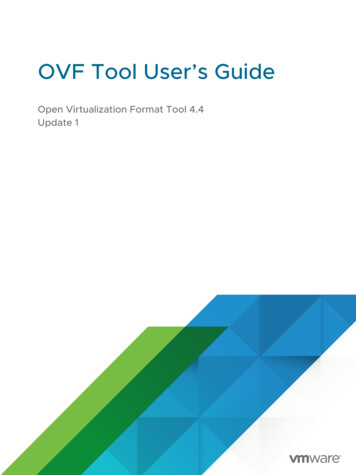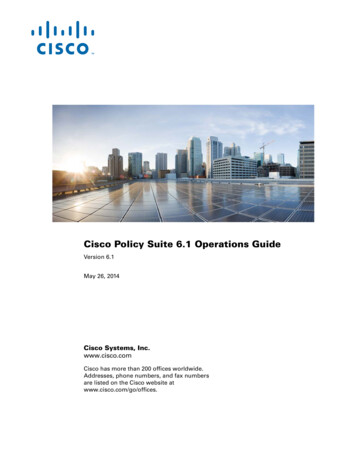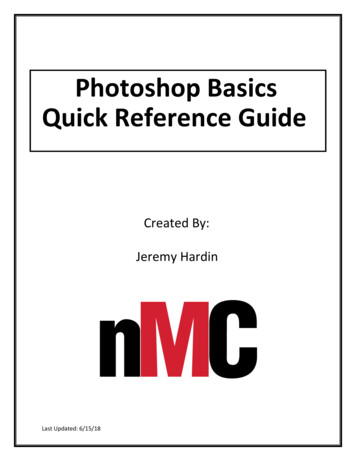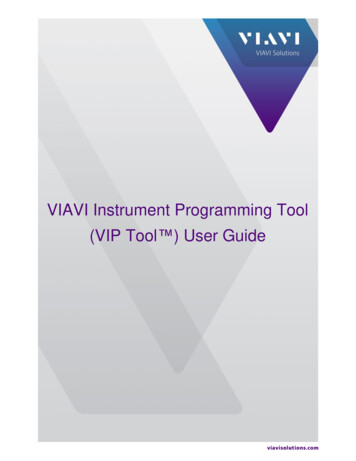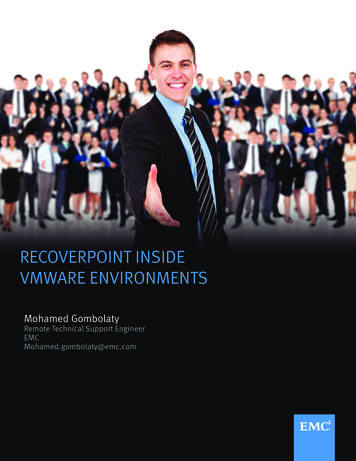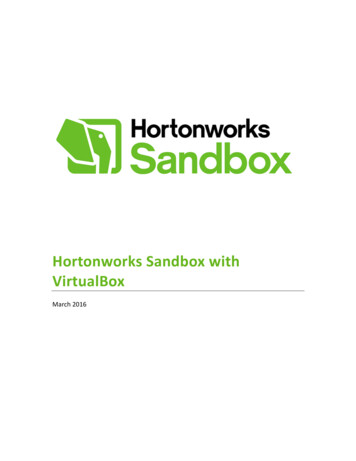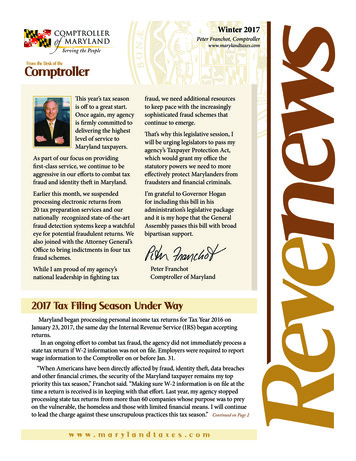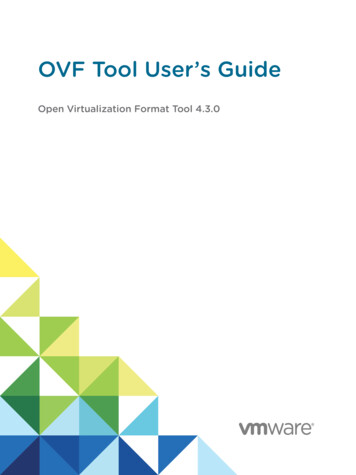
Transcription
OVF Tool User’s GuideOpen Virtualization Format Tool 4.3.0
OVF Tool User’s GuideYou can find the most up-to-date technical documentation on the VMware website at:https://docs.vmware.com/If you have comments about this documentation, submit your feedback todocfeedback@vmware.comVMware, Inc.3401 Hillview Ave.Palo Alto, CA 94304www.vmware.comCopyright 2009–2018 VMware, Inc. All rights reserved. Copyright and trademark information.VMware, Inc.2
ContentsAbout This Book51 Overview of the OVF Tool 7The Open Virtualization FormatUsing the VMware OVF ToolExamples of OVF Tool Use7892 Using the VMware OVF Tool 12Definitions and Command SyntaxCommand-Line OptionsSpecifying a LocatorConfiguration Files121423313 Examples of OVF Tool Syntax 34Supported File Types and Package FormatsChanging File or Package FormatsSetting OVF Package PropertiesModifying an OVF PackageDeploying OVF Packages3436383940Importing an OVF Package41Exporting Virtual Machines to OVF PackagesDisplaying Summary Information4243Validating an OVF 1.0 or OVF 1.1 Descriptor43Downloading an OVF Package from a Protected Web SiteUsing a Proxy4344Overwriting a Running Virtual Machine or vApp from vSphereCanceling the VMware OVF Tool While it Is Running44444 OVF Package Signing 45Creating an RSA Public/Private Key Pair and CertificateSigning an OVF Package4546Validating an OVF Package475 Using the VMware OVF Tool Probe Mode 48About OVF Tool Probe ModeExample of Probe ModeVMware, Inc.48483
OVF Tool User’s Guide6 Using the VMware OVF Tool Machine Mode 50About Machine Mode50Running Machine Output51Example Output 53VMware, Inc.4
About This Book This OVF Tool User’s Guide provides information about how to use VMware OVF Tool to package virtualmachines and vApps into Open Virtualization Format (OVF) standard packages.Revision HistoryA revision occurs with each release of the product, or as needed. A revised version can contain minor ormajor changes. Table 1 lists the versions of this manual.Table 1. Revision HistoryRevisionDescription05/2018OVF Tool 4.3.0 User’s Guide. Large upload retry, SHA digest fix, NVM and PMEM, Curl update, better logging, VBSand TPM support.10/2016OVF Tool 4.2.0 User’s Guide. New options for SSL version and cipher list, NVRAM support for EFI boot.02/2016Mention need for explicit extraConfig flags on ESXi hosts.03/2015OVF Tool 4.1.0 User’s Guide. Added DVS port group, viUseProxy option for vSphere, and vCloud locators.12/2014Increased Open SSL compatibility version to 1.0.1j. See 0/2014OVF Tool 4.0.0 User’s Guide. Added --allowAllExtraConfig and --decodeBase64 command line options.06/2014OVF Tool 3.5.2 User’s Guide. Increased security for Open SSL.04/2014OVF Tool 3.5.1 User’s Guide.08/2013OVF Tool 3.5.0 User’s Guide. Includes new command line options.08/2012OVF Tool 3.0.1 User’s Guide.08/2011OVF Tool 2.1 User’s Guide.06/2010OVF Tool 2.0.1 Guide.05/2009OVF Tool 1.0 Guide.Intended AudienceThis book is intended for anyone who needs to convert an OVF package to a virtual machine, or a virtualmachine to an OVF package. Users typically include: system administrators, software developers, QAengineers, and anyone who need to package or unpackage virtual machines using open industrystandards.VMware, Inc.5
OVF Tool User’s GuideDocument FeedbackVMware welcomes your suggestions for improving our documentation. If you have comments, send yourfeedback to docfeedback@vmware.com.Technical Support and Education ResourcesThe following sections describe the technical support resources available to you. To access the currentversion of this book and other books, go to http://www.vmware.com/support/pubs.OVF Tool Users’ ForumTo obtain more information and to post questions about OVF Tool, go to the OVF Tool Forum athttp://www.vmware.com/go/ovftool.Support OfferingsTo find out how VMware support offerings can help meet your business needs, go tohttp://www.vmware.com/support/services.VMware, Inc.6
Overview of the OVF Tool1Open Virtualization Format (OVF) is an industry standard to describe metadata about virtual machineimages in XML format. VMware OVF Tool is a command-line utility that helps users import and exportOVF packages to and from a wide variety of VMware products.This chapter includes the following topics:nThe Open Virtualization FormatnUsing the VMware OVF ToolnExamples of OVF Tool UseThe Open Virtualization FormatVMware implemented a tool for importing and exporting virtual machines in OVF standard format.The OVF StandardThe OVF specification describes a secure, portable, efficient, and flexible method to package anddistribute virtual machines and components. It originated from the Distributed Management Task Force(DMTF) after vendor initiative. Companies that contributed to the OVF standard include VMware, Dell, HP,IBM, Microsoft, XenSource, and Citrix.Version 1.1 was published in January 2010, which supersedes the 1.0 specification published April 2009,and is available on the DMTF Web site, along with a white paper.nSpecification: http://www.dmtf.org/standards/published documents/DSP0243 1.1.0.pdfnWhitepaper: http://www.dmtf.org/standards/published documents/DSP2017 1.0.0.pdfBenefits of OVFUsing OVF to distribute virtual machines has the following benefits:nEase of use. When users receive a package in OVF format, they do not have to unzip files, executebinaries, or convert disk formats. Adding a vApp can be as simple as typing a URL and clickingInstall.VMware, Inc.7
OVF Tool User’s GuidenVirtual hardware validation. OVF supports fast and robust hardware validation. You do not have toinstall a complete virtual machine before determining whether it is compatible with an ESXi host (forexample, because it uses IDE virtual disks).nMetadata inclusion. Additional metadata, such as an end-user license agreement, can be packagedwith the OVF and displayed before installation.nOptimized download from the Internet. Large virtual disks are compressed for fast download and toreduce disk space for large template libraries.Using the VMware OVF ToolThe VMware OVF Tool is available on many platforms and can be downloaded if not built into a product.VMware Platforms Using the OVF StandardVMware supports the OVF standard on the following platforms:nUse the OVF Tool 3.x for vSphere 4.0 and later, vCloud Director 1.5, 5.1, and 5.5, vCloud Director 1.0(for OVF and OVA types only), vCenter 2.5 and later, ESX 3.5 and later, VMware Server 2, VMwareWorkstation 6.0 and later, and VMware Fusion 3.0 and later.nOVF 0.9 is supported for import and export by VirtualCenter 2.5 and later, and ESX 3.5 and later.nVMware Studio 1.0 and later can generate OVF packages.OVF support is built into the vSphere Client that installs from, and is compatible with vCenter 5.0 andESXi 5.0, vCenter 4.0 and ESX 4.0. It is also built into the vSphere Client that installs from and iscompatible with VirtualCenter 2.5 and later, and ESX 3.5 and later. The vSphere 5.1 Web Client includesthe 3.x version of the VMware OVF Tool as part of the Client Integration Plug-in.Setting Up the OVF ToolYou can find the latest information about System Requirements, supported VMware software andplatforms, installation, and known issues by reading the latest release notes located at the following webpage: www.vmware.com/support/developer/ovf.OVF Tool HighlightsThe OVF Tool provides the following key features:nSupports import and generation of OVA packages (OVA is part of the OVF standard, and contains allthe files of a virtual machine or vApp in a single file.)nDirectly converts between any vSphere, vCloud Director, VMX, or OVF source format to any vSphere,vCloud Director, VMX, or OVF target formatnAccesses OVF sources using HTTP, HTTPS, FTP, or from a local filenDeploys and exports vApp configurations on vSphere 4.0 (and all newer) targets and on vCloudDirector 1.5 (and all newer) targetsVMware, Inc.8
OVF Tool User’s GuidenProvides options to power on a VM or vApp after deployment, and to power off a virtual machine orvApp before exporting (caution advised)nShow information about the content of any source in probe modenProvides context sensitive error messages for vSphere and vCloud Director sources and targets,showing possible completions for common errors, such as an incomplete vCenter inventory path ormissing datastore and network mappingsnProvides an optional output format to support scripting when another program calls OVF ToolnUses new optimized upload and download API (optimized for vSphere 4.0 and newer)nSigns OVF packages and validates OVF package signaturesnValidates XML Schema of OVF 1.0 and OVF 1.1 descriptorsnImport and export of OVF packages into a vApprun 1.0 workspace.For more information about vApprun, see http://labs.vmware.com/flings/vapprun.Examples of OVF Tool UseOVF import and export are built into the vSphere Client and the vSphere Web Client, and various otherenterprise oriented VMware products.For VMware products without built-in OVF support, or when you need to accomplish specialized OVFoperations, you can download the OVF Tool over the Web.Importing and Exporting OVF Using vSphere ClientUsing the vSphere 5.0 or 4.0 Client, you can import an OVF package and export a vApp into an OVFpackage. For example, to import an OVF package using vSphere Client 4:Click File Deploy OVF Template.For example, to export a vApp into an OVF package using vSphere Client 4:Click File Export OVF Template Export.Using the vSphere Client 2.5, you can import an OVF virtual machine into an ESXi host and export avirtual machine to an OVF file (note that vSphere Client 2.5 is limited to OVF 0.9). For example, to importan OVF vApp into an ESXi host using vSphere Client 2.5:Click File Virtual Appliance Import .For example, to export a virtual machine to an OVF file using vSphere Client 2.5:Click File Virtual Appliance Export .OVF packages imported or exported by OVF Tool are completely compatible with packages imported orexported by the vSphere Client or the vSphere Client.VMware, Inc.9
OVF Tool User’s GuideVMware OVF Tool Delta Disk FacilitiesVMware OVF Tool automatically compresses disk files. In the streaming VMDK files that OVF Toolgenerates, the tool compresses each 64KB disk grain. It is possible to achieve even better compressionusing the --compress option. In addition, if a package contains multiple virtual machines, it is possible tocompress an OVF package even more using a technique called delta disk compression. Thiscompression algorithm is invoked using the --makeDeltaDisks option.ovftool --makeDeltaDisks package.ovf output-dir/Delta disk compression identifies disk segments that are equal and combines these equal parts in aparent disk. This process prevents storing the same segment twice.As an example, consider a software solution that consists of an Apache Web server virtual machine and aMySQL database virtual machine, both installed on top of a single-disk Ubuntu server. The two virtualmachines were created with the following process:1Create a plain Ubuntu installation on one virtual machine.2Clone the virtual machine.3Install Apache on the first virtual machine.4Install MySQL on the second virtual machine.Using delta disk compression on the two virtual machine disks creates a parent disk containing all of theinformation they share, which is essentially the entire operation system and two child disks containing theMySQL and Apache parts.A plain Ubuntu server can use 400–500MB of space, and two would use 800–1000MB of space. Bycontrast, using delta disk compression, an OVF package with these two servers uses only 400–500MB(plus the size of the MySQL and Apache installations), which saves 400–500MB by not duplicating theUbuntu server.Any number of disks can be combined creating various disk trees and saving more space.vSphere 4 and later support the deployment of OVF packages that contain delta disk hierarchies.For delta disk compression, keep in mind the following:nOnly disks with equal capacity can be combined. If you expect to use delta disk compression, youmust keep disk capacities equal.nDelta disk compression necessitates that segments that might be put in a parent disk are at the sameoffset from the beginning of their respective files. In the Ubuntu example, if the setup varies betweenthe two installations, it can completely offset each segment on one of the disks from the segments onthe other disk. In this case, delta disk compression does not produce any significant disk spacesavings. This is why the example specified cloning the Ubuntu server before installing the MySQLand Apache parts, respectively.nDelta disk compression takes OVF packages and vSphere and VMX files as input, but not OVApackages.VMware, Inc.10
OVF Tool User’s GuidenThe delta disk compression algorithm needs to read the contents of each disk up to two times. Itmight make sense to invoke OVF Tool on a local copy of the OVF package.nThe delta disk compression algorithm always generates an OVF package in the given outputdirectory. To convert this OVF package into an OVA package, reinvoke OVF Tool.VMware, Inc.11
Using the VMware OVF Tool2The VMware OVF Tool is a command-line utility that supports importing and exporting of OVF packages,VMX files, or virtual machines from ESXi hosts and other VMware products.This chapter includes the following topics:nDefinitions and Command SyntaxnCommand-Line OptionsnSpecifying a LocatornConfiguration FilesDefinitions and Command SyntaxA source location or source URL locator refers to an OVF package, VMX file, or virtual machine in aVMware product, such as VMware Workstation, vSphere ESXi Host, vSphere vCenter Server, vCloudDirector, or vFabric Data Director.A target location or destination URL locator specifies either a file location, or a location within a VMwareproduct, such as VMware Workstation, ESXi, vCenter Server, vCloud Director or vFabric Data Director.Run VMware OVF Tool From the Command LineProcedure1At the command-line prompt, run the OVF Tool as followsovftool source locator target locator source locator and target locator are paths to the source and target for the virtualmachine, OVF package, OVA package, or vSphere location. See Command-Line Options for options.Table 2‑1 describes the source and target locators. For details, see Specifying a Locator.If you are using an operating system where spaces are not allowed in paths on the command line,and need the full path to run OVF Tool, enclose the path in quotes as shown below:"/Applications/VMware OVF Tool/ovftool" --helpVMware, Inc.12
OVF Tool User’s Guide2If you want to specify additional options, type them before the source and target locators.ovftool options source locator target locator 3To display all options, type ovftool -h.Probe mode allows you to investigate the contents of a source. To invoke probe mode, use theovftool command with only a source and no target. OVF Tool prints information about the sourcesuch as hardware, EULA, and OVF properties.ovftool options source locator Use probe mode to examine an OVF package before deploying it. For example, you can examine thedownload and deployment sizes, determine the set of networks to be mapped, determine the OVFproperties to be configured, read the EULA, and determine the virtual hardware requirements.The probe operation is fast, as it only needs to access the OVF descriptor. It does not need todownload the entire OVA or VMDK files. Probe mode also validates the certificate if the source issigned. For details about Probe Mode and sample output, see Chapter 5 Using the VMware OVF ToolProbe Mode.Run OVF Tool from ESXi instead of vCenterIf you are deploying with the ovftool command from vCenter Server, you can use the command lineoptions in the table below to specify parameters when you deploy.If you are deploying with the ovftool command from an ESXi host, you must “inject” the parameters intothe resulting VM when it is powered on. This is because the ESXi host lacks a cache to store the OVFparameters, as in vCenter Server. Therefore, you must use the --X:injectOvfEnv debug option with the--poweron flag in the command line if you are deploying a virtual machine from ESXi. Example below.(You can also do this using the Create a VM from an OVA/OVF option in the ESXi host client, thenbrowse to the .ova file.) ./ovftool/ovftool\--name "Cloudvm 2074586 with inject"\--X:injectOvfEnv\--X:logFile ovftool.log\--X:logLevel trivia\--acceptAllEulas\-ds cl-storage-1\-dm thin\--net:'Network 1 VM mask0.VMware vCenter Server Appliance refix 24\--prop:guestinfo.cis.appliance.net.gateway s-sync True\VMware, Inc.13
OVF Tool User’s Guide--prop:vami.gateway.VMware vCenter Server Appliance ervers X.X.X.1,X.X.X.2\--prop:vami.ip0.VMware vCenter Server Appliance wd vmware\--prop:guestinfo.cis.appliance.net.addr X.X.X.145\--prop:vami.DNS.VMware vCenter Server Appliance X.X.X.1,X.X.X.2\--prop:vami.vmname hell e True\--prop:guestinfo.cis.appliance.ssh.enabled True\--prop:guestinfo.cis.appliance.net.mode ily ipv4\--prop:guestinfo.cis.vmdir.domain-name vsphere.local\--prop:guestinfo.cis.vmdir.password vmware\--powerOn\--X:waitForIp\http:// directory w/cloudvm X OVF10.ovf\vi://root:pwd@vm nameYou will need to replace the variables (IP addresses, build numbers, root password, and VM names) inthe above example with values from your own system.Deploy a Virtual Machine to Static DVS Port GroupAt this time, you can not use the OVF Tool to deploy a virtual machine to a static port group.To work around this issue:Procedure1Use vCenter Server to create an ephemeral port on the desired network.2Deploy the appliance to that port group on an ESXi host.3Switch the appliance over to that static port group.4Use vCenter Server to delete the ephemeral port group.Command-Line OptionsFor every command, you specify the source and target locators. Table 2‑1 defines each locator type.VMware, Inc.14
OVF Tool User’s GuideTable 2‑1. OVF Tool Definitions of Source and Target LocatorsLocatorDefinition source locator Path to the source, which must be either a virtual machine, vApp, vApprun workspace entity, or anOVF package.The source locator can be one of the following: target locator nA path to an OVF or OVA file (a local file path, or an HTTP, HTTPS, or FTP URL).nA virtual machine (a local file path to a .vmx file).nA vSphere locator identifying a virtual machine or vApp on vCenter, ESXi, or VMware Server.nA vCloud Director locator identifying a virtual machine or a vApp in vCloud Director.nA local file path to a vApprun workspace entity.The target locator can be one of the following:nA local file path for VMX, OVF, OVA, or vApprun workspace.nA vSphere locator identifying a cluster, host, or a vSphere location.nA vCloud Director locator identifying a virtual machine or a vApp in vCloud Director.Table 2‑2 shows all the command-line options.Options perform actions only between certain source and target types. Table 2‑2 shows which source andtarget types each option works with. If you specify an option using an irrelevant source or target type, thecommand does nothing.All options can be set using the form --option value.Binary options can be enabled or disabled explicitly. For example: --option true, --option false.Table 2‑2. OVF Tool Command-Line OptionsOption's Long sOVF,OVAN/A--allowExtraConfigDescriptionAccepts all end-user licenses agreements (EULAs) withoutbeing prompted. Binary option.Lets you specify the extra config options that can be convertedto .vmx format. These options are a security risk as they controllow-level and potential unsafe options on the VM. Each optionmust be specified using a series of key value pairs (sometimesreferred to as a white list).--allowAllExtraConfigConverts all extra config options to .vmx format. Flags must beexplicitly specified on ESXi hosts, but with vCenter Server -exportflags extraconfig produces phereAdds annotation to vi, vmx, vapprun, vCloud, OVF, and OVAsource locators.vSphereOverrides default VMware authd port (902) when using a hostas source.--authdPortTargetvSpherevSphereOverrides the default VMware authd port (902) when using ahost as target.VMware, Inc.15
OVF Tool User’s GuideTable 2‑2. OVF Tool Command-Line Options (Continued)Option's Long riptionN/AOVF,OVASpecifies the chunk size to use for files in a generated OVF orOVA package. The default is not to chunk.If you don’t specify a unit for the chunk size, the chunk size isassumed to be in megabytes (mb). Accepted units are b, kb,mb, gb. Example: 2gb or 100kb.When using this option, all output files (except the OVFdescriptor, manifest and certificate files) are sliced into thespecified chunk size. This is useful if you need to transport anOVF package on a series of 800MB CD-ROMs, or are only ableto create files up to 2GB on FAT32 file systems.When you use chunking with the OVA package option, theresult is similar to OVF because all the files are chunked, butthe OVA package is still be a single file.--compressN/AOVF,OVA--computerNameCompresses the disk when given an OVF or OVA target locator.The value must be between 1 and 9. Use 9 for the slowestprocessing time, but best compression. Use 1 for the fastestprocessing time, but least compression.Sets the computer name in the guest for a VM using the syntax--computerName: VM ID value .Only applies to vCloud targets of version 5.5 or newer.--coresPerSocketSpecifies the distribution of the total number of CPUs over anumber of virtual sockets using the syntax -coresPerSocket: VM ID value . Only applies to vCloudtargets of version 5.5 or newer.--datastore-dsN/AvSphereTarget datastore name for a vSphere locator.--decodeBase64Enables Base64 decoding for values in the OVFTool commandline.--defaultStorageProfileThe storage profile for all VMs in the OVF package. The valueshould be an SPBM profile ID. Only applies to VI targets ofversion 5.5 or newer.-defaultStorageRawProfileThe storage profile for all VMs in the OVF package. The valueshould be a raw SPBM profile. The value overwrites that in -defaultStorageProfile. Only applies to VI targets of version5.5 or newer--deploymentOptionOVF,OVAN/ADeployment options for a deployed OVF package (if the sourceOVF package supports multiple options.) An OVF package cancontain several deployment configurations. This option allowsyou to select which configuration to use when deploying to thevSphere target.--disableVerificationOVF,OVAN/ASkips validation of signature and certificate. Binary option.VMware, Inc.16
OVF Tool User’s GuideTable 2‑2. OVF Tool Command-Line Options (Continued)Option's Long AVMX,vApprun,vSphere--diskSizeDescriptionSelect target disk format. Supported formats are:monolithicSparse, monolithicFlat, twoGbMaxExtentSparse,twoGbMaxExtentFlat, seSparse (vSphere target),eagerZeroedThick (vSphere target), thin (vSphere target), thick(vSphere target), sparse, and flat.Sets the size of a VM disk in megabytes using the syntax -diskSize: VM ID , disk instance ID value . Onlyapplies to vCloud targets of version 5.5 or newer.--eulaN/AOVF,OVAInserts the EULA in the first virtual system or virtual systemcollection in the OVF. If the EULA is in a file, use the format:--eula@ filename--exportFlagsSpecifies the source of an export. The supported values forvSphere source are: mac, uuid, and extraconfig.The supported value for vCloud source ispreserveIdentity.You can provide one or more options, separated by commas.--extraConfigN/AAllSets an ExtraConfig element for all VirtualHardwareSections.The syntax is --:extraConfig: key value This option applies to vi, vmx, vapprun, vCloud, ovf, and ovasource locators--fencedMode--helpvCloud-hIf a parent network exists on a vCloud target, this optionspecifies the connectivity to the parent. Possible values arebridged, isolated, allowIn, allowInOut, allowOut.N/AN/APrints the VMware OVF Tool help message that lists the - helpoptions.--hideEulaOVF,OVAN/ADoes not include the EULA in the OVF probe output. n option. Interpret arguments for networks, datastores,and folders as VIM Managed Object Reference identifiers(type:id) for vSphere source and destination gration option. Specifies the session ticket used forauthenticating the vSphere source ration option. Specifies the session ticket used forauthenticating the vSphere target locator.--ipAllocationPolicyOVF,OVAN/AIP allocation policy for a deployed OVF package. Supportedvalues are: dhcpPolicy, transientPolicy, fixedPolicy, orfixedAllocatedPolicy.In OVF descriptors, you can specify a VMware specific IPassignment policy that guides the deployment process byexpressing which of the policies the OVF package supports.Only values listed in the OVF descriptor are supported when theOVF or OVA package is deployed.VMware, Inc.17
OVF Tool User’s GuideTable 2‑2. OVF Tool Command-Line Options (Continued)Option's Long ,OVAN/ADescriptionSpecifies which IP protocol to use. For example, IPv4, IPv6. Aswith the ipAllocationPolicy option, you can specify which IPversion this OVF package uses when it is deployed. Use onlythe values listed in the OVF descriptor.--laxOVF,OVAN/ARelax OVF specification conformance and virtual hardwarecompliance checks. (For advanced users only.)--localeOVF,OVAN/ASelects the locale for the target.--machineOutputN/AN/AOutputs OVF Tool messages in a machine readable format.Binary option.--makeDeltaDisksOVF,vSphere,VMX,vApprunMust bedirectoryUse delta disk compression to create an OVF package from adisk source. Binary option.--maxVirtualHardwareVersionThe maximal virtual hardware version to generate.--memorySizeSets the memory size in megabytes of a VM using the syntax--memorySize: VM ID value . Example: -memorySize:vm1 1024. Applies to VI and vCloud targets ofversion 5.5 or newer.--name-n--netN/AAllSpecifies the target name. Defaults to the source name.OVF,OVAN/ASets a network assignment in the deployed OVF package. Forexample, --net: OVF name target name . OVF packagescontain symbolic names for network names which are assignedwith this option.For multiple network mappings, repeat the option, separatingthem with a space for example, --net:s1 t1 --net:s2 t2--net:s3 t3.If the target is vCloud 5.5 or newer, a fence mode can also bespecified using the syntax --net: OVF name targetname , fence mode . Possible fence mode values are:bridged, isolated, and natRouted.--network-nwOVF,OVAN/ATarget network for a vSphere deployment. Use this option inplace of the --net option when only one network exists in theOVF package. This option maps the symbolic OVF name to thespecified network name.--nicSpecifies NIC configuration in a VM using the syntax -nic: VM ID , index OVF netname , isPrimary , ipAddressingMode , ipAddress .Possible values for ipAddressingMode are:DHCP, POOL, MANUAL, and NONE. ipAddress is optional andshould only be used when ipAddressingMode is set to MANUAL.Only applies to vCloud targets of version 5.5 or newer.VMware, Inc.18
OVF Tool User’s GuideTable 2‑2. OVF Tool Command-Line Options eates and uploads the virtual machine or vApps but does notupload any disk files. Disks are created empty. (Disables diskconversion.)--noImageFilesN/AAllCreates and uploads the virtual machine or vApps but does notupload ISO files to a CD-ROM. (Does not include image files indestination.Option's Long NameShortNameDescription--noSSLVerifySkip SSL verification for vSphere connections.--numberOfCpusSets the number of CPUs for a VM using the syntax -numberOfCpus: VM ID value . Applies to VI and vCloudtargets of version 5.5 or newer.--overwrite-oN/AAllForces an overwrite of existing files. Binary option.--powerOffSourcevCloud,vSphereN/AEnsures that a virtual machine or vApp is powered off beforeimporting from a vSphere source. Binary option.--powerOffTargetN/AvCloud,vSphereEnsures that a virtual machine or vApp is powered off beforeoverwriting a vSphere target. Binary option.--powerOnN/AvCloud,vSpherePowers on a virtual machine or vApp deployed on a vSpheretarget. Binary option.--privateKeyN/AOVF,OVAThe file must contain a private key and a certificate.--privateKeyPasswordN/AOVF,OVASigns the OVF package with the given private key (.pem file).Password for the private key. Used in conjunction with -privateKey if the private key requires password authentication.If required but not specified, the tool prompts for the password.--propOVF,OVAN/ASets a property in the deployed OVF package. For example, -prop: key value . Use probe mode to learn whichproperties an OVF package can set. For multiple propertymappings, repeat the option, separating them with a blank, forexample --prop:p1 v1 --prop:p2 v2 --prop:p3 hereSpecifies the proxy used for HTTP, HTTPS,FTP, vSphere and vCloud access. The proxy is expressed asthe URL to the proxy.For example, for proxy.example.com, the option value is:https://proxy.example.com:345OVF Tool supports proxies that require authentication. If you donot provide credentials in the URL, the OVF Tool prompts youfor them.You can
Click File Virtual Appliance Import . For example, to export a virtual machine to an OVF file using vSphere Client 2.5: Click File Virtual Appliance Export . OVF packages imported or exported by OVF Tool are completely compatible with packages imported or exported by the vSphere Client or the vSphere Client. OVF Tool User's Guide
